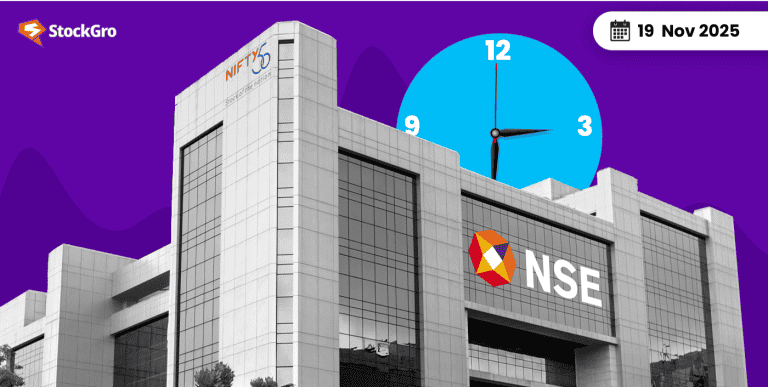
Prices can rise, fall, or move sideways, but the real push behind these moves lies in the battle between buyers and sellers. The candles alone don’t show that fight, as two candles might look the same on a chart while having completely different strengths inside them.
That’s exactly where Volume Delta steps into the fight, revealing which side actually holds the power. It measures the net difference between the buying and selling volume, giving a clear view of who is in control and whether a move has genuine force or just empty noise.
This blog is a complete guide to the Volume Delta indicator, how it is calculated, and how a trader might incorporate it into their trading strategies.
What is Volume Delta?
Volume Delta is an order flow indicator used in trading, which measures the difference between the buying and selling pressure of a stock or security in a market over a period of time.
When the volume delta is positive, it indicates the buying pressure is greater, while a negative delta shows that selling pressure is dominant. The traders use it to evaluate the market sentiment, confirm trends, identify reversals, and measure the aggression of the buyers and the sellers.
How Volume Delta is Calculated?
The Volume Delta is calculated by subtracting the volume of sell orders from the volume of buy orders, or ask volume minus bid volume. The formula is Volume Delta = Ask Volume – Bid Volume.
Let’s take an example to understand volume delta calculation. Let’s say MNB Limited is trading around ₹2,450. In a 5-minute candle, the market buy orders total is 1,20,000 shares, that is the ask volume, while the market sell orders total is 95,000 shares, the bid volume.
So, here Volume Delta = 1,20,000 – 95,000 = 25,000 (Positive Delta)
In this case, even if the price only moved slightly in that 5-minute candle, a positive delta of 25,000 represents that the buyers were clearly stronger, and their pressure was behind the move.
Difference between Volume Delta and Cumulative Volume Delta (CVD)
| Features | Volume Delta | Cumulative Volume Delta |
| Represents | It provides a view of the immediate buying or selling pressure for a time period | It gives an overall view of buying and selling pressure, and the market trends over a longer period |
| Purpose | it shows the immediate pressure in one bar | It shows the overall trend and pressure |
| Time Frame | It is calculated for a short-term, per bar | It is a running total over a long-term |
| Calculation | It is the difference between the asks and bids in a particular period | It is the sum of all the volume deltas over time |
Using Volume Delta in Your Trading Strategy
Let’s understand how the traders can incorporate the volume delta trading strategy!
Entry & exit signals
The volume delta sharpens the entry and exit signals by showing whether the price moves carry real strength or fading pressure.
The divergence between the price and Cumulative Volume Delta (CVD) warns of weakening momentum and possible reversals, while the confluence confirms trend continuation.
The absorption hints at hidden accumulation, exhaustion reveals momentum burnout, and strong delta reactions at support or resistance levels help in timing entries and exits.
Stop-loss, target setting & risk management
The volume delta helps the traders to place stop-loss orders and target settings by using actual order flow instead of relying only on the chart patterns for managing risk.
The traders might set stop-loss around the support or resistance zones or just beyond the candle where the delta first hinted at a shift. And, the targets might be set around low-volume pockets or opposing value areas where the price usually reacts.
The volume delta can be used as a confirmation tool, and by combining it with price action and other technical analysis tools, it can filter out false signals in volatile markets. It also helps in position sizing for risk management, which limits the capital at risk on any single trade.
Volume Delta vs Other Indicators
Here’s how the volume delta indicator differs from other indicators, such as volume profile and footprint charts.
Volume Delta vs Volume Profile / Footprint Charts
| Features | Volume Delta | Volume Profile | Footprint Charts |
| Represents | It represents the difference between the buyer and seller volume at a price | It represents the total trading volume at each price level throughout a time period | It provides a detailed breakdown of buying and selling volume within each price bar |
| Focus | It is focused on aggressive buying and selling pressure | It focuses on where volume is concentrated to identify support and resistance | It focuses on how volume is distributed in relation to price changes |
| Data Granularity | It measures a single point or time frame | It horizontally displays price, and not time | It measures intra-bar detail, showing volume at each price level within a bar |
| Use Case | It helps in assessing market sentiment and trend strength | It helps in identifying trading zones and turning points | It helps in determining support-resistance level, entry-exit points, and reversals, based on volume imbalances |
Common Mistakes & Limitations of Volume Delta
The mistakes or limitations while using the volume delta indicator could be as mentioned under:
- Treating it as a Standalone Tool: The most significant mistake is using volume delta alone for trading decisions. It must be combined with other tools such as price action and other technical indicators, for example, Moving Averages, RSI, support/resistance levels.
- Misinterpreting Volume Spikes: It would be wrong to assume every volume spike is institutional activity or a strong trend. The spikes might be caused by temporary factors like news events, algorithmic trading, or speculative retail activity.
- Lagging Signals or False Signals in Volatility: In highly volatile or illiquid markets, volume delta might lag or produce false signals, as small volume rises might appear significant but lack sustainable market interest.
When Volume Delta signals fail / myths
Myth:
- ‘High volume always confirms a trend’: The high volume can also indicate profit-taking, distribution, or panic selling, which may precede a reversal, and necessarily not a continuation.
- ‘All volume spikes are significant’: The spikes might be temporary noise from news or algorithms and not reflect a sustainable market direction.
Failure during Absorption:
- The volume delta signals might fail when large, passive orders absorb aggressive market orders.
- For example, a strong positive delta or aggressive buying might fail to move the price up if an even larger limit sell order is absorbing all the buying pressure at a certain price level, leading to a reversal.
Importance of context-filters (volume, market state)
Volume filter: When the volume delta is filtered using the overall total volume, it separates real conviction from noise. When delta spikes with heavy volume, the move carries conviction. When the same delta appears on low volume, it often signals weak or false momentum.
Market state: The volume delta behaves differently in each market phase. In trends, a fading delta warns of slowing strength, in ranges, the absorption blocks breakouts, while in volatile periods, traders rely on broader delta behaviour instead of short spikes.
Bottom line
The volume delta helps the traders to look beyond the candles and understand the real pressure that drives every move. It reveals who is in control, confirms strong trends, and warns when the momentum is fading.
When volume delta is combined with price action, support-resistance zones, and total volume, it becomes a reliable tool for timing entries, exits, and managing risk. While it doesn’t predict the market, however, it sharpens decision-making.
FAQ‘s
Volume Delta is an order flow indicator used in trading, which measures the difference between the buying and selling pressure of a stock or security in a market over a period of time. The traders use it to evaluate the market sentiment, confirm trends, identify reversals, and measure the aggression of the buyers vs sellers.
The Volume Delta is calculated by subtracting the volume of sell orders from the volume of buy orders, or ask volume minus bid volume. The formula is Volume Delta = Ask Volume – Bid Volume.
When the volume delta is positive, it indicates the buying pressure is greater, while a negative delta shows that selling pressure is dominant.
The traders might use it to confirm trends, spot reversals through divergence, and identify absorption or exhaustion. It also helps in timing entries and exits when combined with price action and support and resistance levels.
The Volume Delta represents the buying or selling pressure for one candle or period. The Cumulative Volume Delta is a running total, which adds all past deltas together, showing the bigger shift in pressure over time.
The volume delta works for both intraday trading and longer time frames. The traders use it for quick shifts in pressure, as well as use the cumulative view to track the longer trend development.
The common mistakes or limitations of volume delta include relying only on the volume delta, misreading volume spikes, or using it in high-volatility conditions without context, which can lead to false signals.

